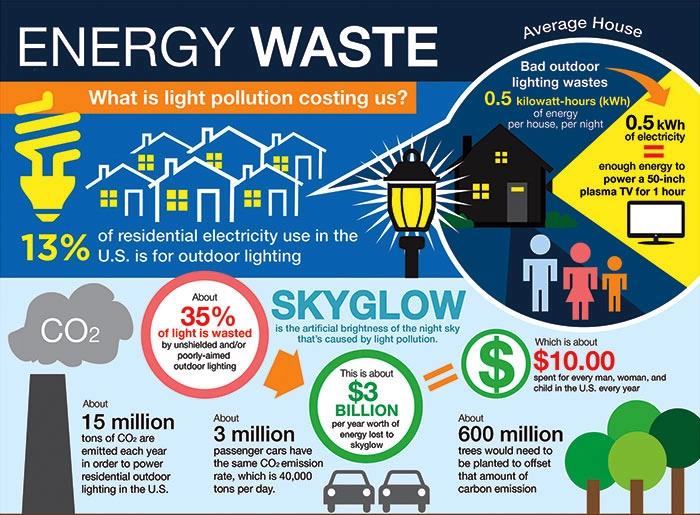Biodiversity & Environment
Skyglow
- 25 Jan 2023
- 6 min read
Prelims: Skyglow, Light Pollution, Circadian Clock, Dark Sky.
Mains: Skyglow and its implications.
Why in News?
Recently, a new study has found that non-natural light had increased the brightness of Skyglow, by 9.2-10% every year between 2011 and 2022 with significant ecological, health and cultural implications.
- Researchers have analyzed a global database of what the dimmest star visible from a particular location is; the database had more than 51,000 entries submitted by citizen scientists.
What is Skyglow?
- The Skyglow, is an omnipresent sheet of light across the night sky in and around cities that can block all but the very brightest stars from view.
- The brightening of the night sky over inhabited areas because of streetlights, security floodlights and outdoor ornamental lights cause the Skyglow.
- This light floods directly into the eyes of the Nocturnal (active at night) and also into the skies and misleads their path.
- 'Skyglow' is one of the components of light pollution.
What is the Scenario of Skyglow?
- Global
- The Skyglow had brightened around 6.5% over Europe, 10.4% over North America, and 7.7% over the rest of the world.
- The finding is significant because it disagrees with satellite-based data, which has indicated that the rate of increase has been around 2% per year.
- The discrepancy is probably the result of the satellites being unable to ‘sense’ blue light emitted by LEDs and to study light that is emitted parallel to the ground.
- India:
- A 2016 study reported that 19.5% of India’s population – the lowest fraction among G20 countries – experiences a level of skyglow that would at least keep the Milky Way galaxy out of sight and at most render “dark adaptation for human eyes” impossible.
- The effects include stimulating the cone cells in human eyes, which is possible only when an environment is considered to be well-lit.
- A 2017 study reported that between 2012 and 2016, India’s lit area increased by 1.07-1.09% and the average radiance of “stably lit areas” – e.g., excluding wildfires – increased by 1.05-1.07%.
What are the Implications of Skyglow?
- Wastes Energy and Money:
- Lighting that emits too much light or shines when and where it’s not needed is wasteful. Wasting energy has huge economic and environmental consequences.
- Disrupting the Ecosystem and Wildlife:
- Plants and animals depend on Earth’s daily cycle of light and dark rhythm to govern life-sustaining behaviors such as reproduction, nourishment, sleep and protection from predators.
- Scientific evidence suggests that artificial light at night has negative and deadly effects on many creatures including amphibians, birds, mammals, insects and plants.
- Ex: Lit beaches deter sea turtles from coming ashore to nest. Skyglow keeps trees from sensing seasonal variations.
- Clownfish eggs don’t hatch when exposed to artificial light at night, killing the offspring.
- Harming Human Health:
- Like most life on Earth, humans adhere to a Circadian Rhythm — our biological clock — a sleep-wake pattern governed by the day-night cycle. Artificial light at night can disrupt that cycle.
- A small 2009 review concluded that circadian disruption – which altered melatonin levels can cause – increased the risk of breast cancer among night-shift workers by 40%.
- The erasure of the night sky acts to erase Indigenous connection to the stars, acting as a form of ongoing cultural and ecological genocide.
What can be the Solutions?
- The researchers recommend light sources casting light at an angle below the plane of the horizon, capping the emissions of these sources and calibrating their output according to the total brightness at the spot being lit.
- Where lights cannot be turned off, they can be shielded so that they do not shed light into the surrounding environment and sky.
- The International Dark-Skies Association has certified more than 130 ‘International Dark Sky Places’, where artificial lighting has been adjusted to reduce skyglow and light trespass. However, nearly all are in developed countries in the northern hemisphere.
- Less-developed regions are often both species-rich and, currently, less light-polluted, presenting an opportunity to invest in lighting solutions before animals there are seriously affected.






-min.jpg)